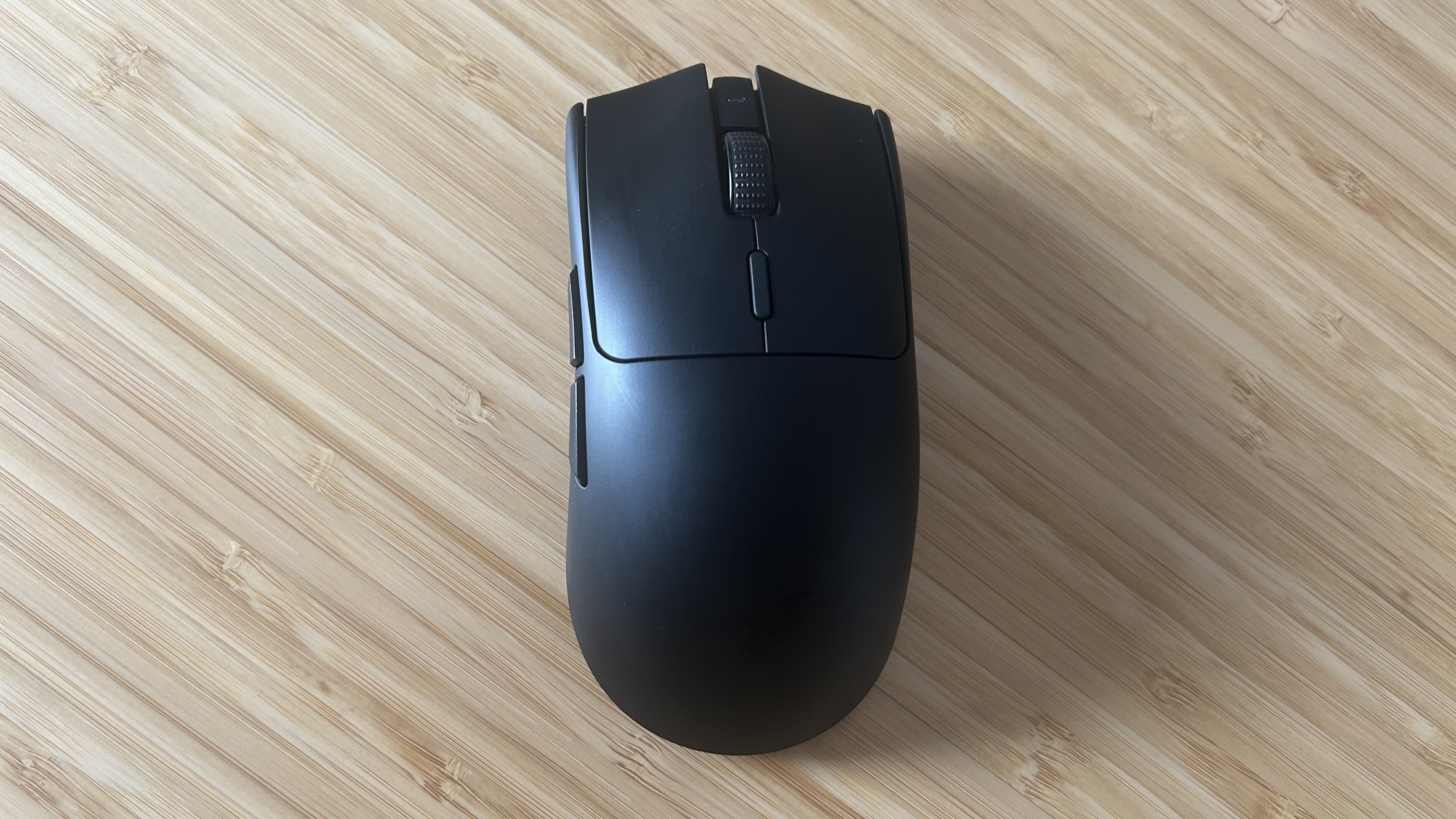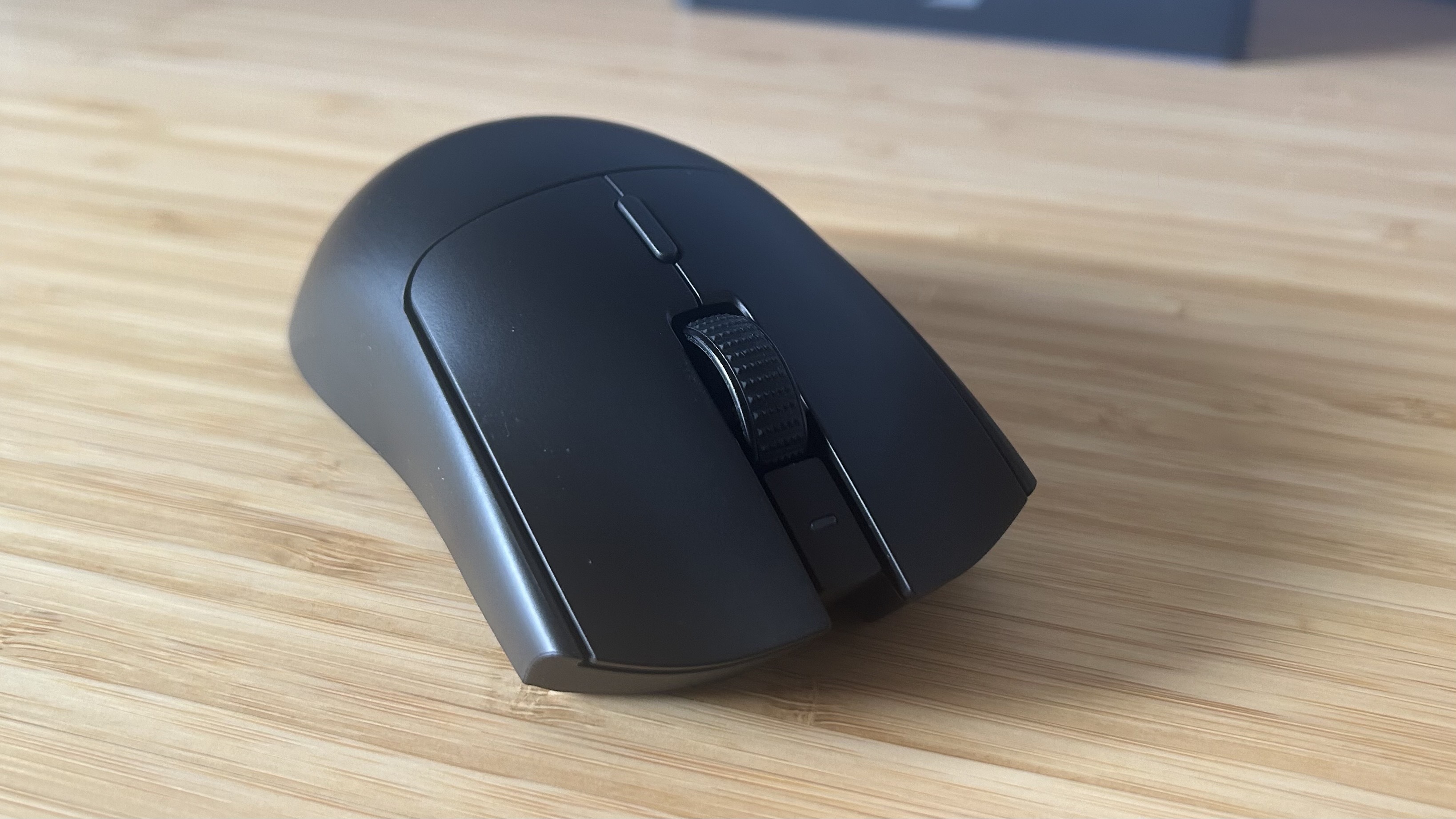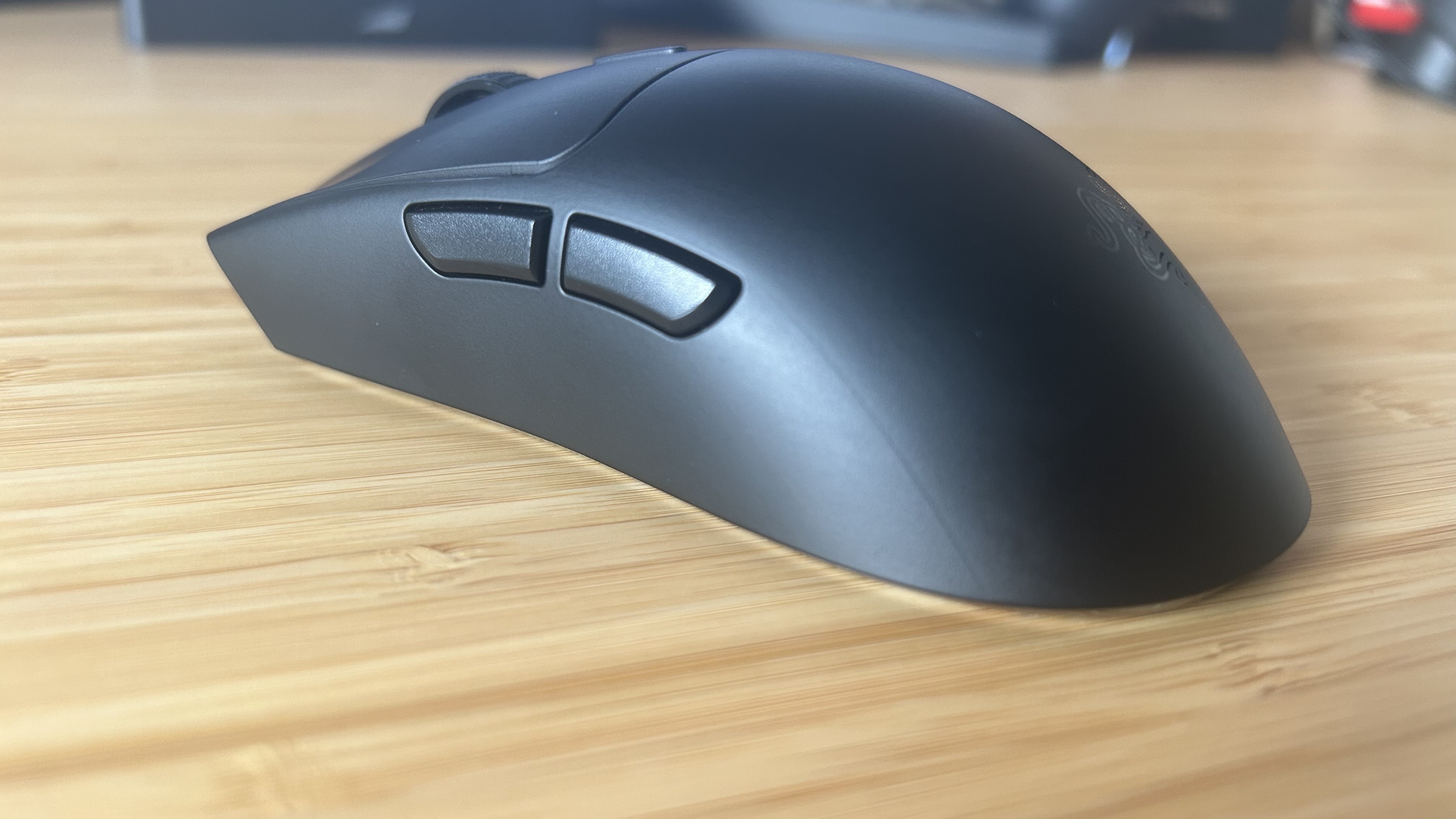GamesRadar+ Verdict
The Razer Viper V3 Hyperspeed is a cheaper option in the Viper line, but it does away with far more than the lofty price. A more comfortable form factor and battery powered design don't deter from the power of that 30K sensor, but there are sacrifices for the $69.99 entry cost that won't be passable for some.
Pros
- +
Solid price point
- +
Super grippy surface
- +
More comfortable shape than previous entries
- +
High quality sensor for the price
Cons
- -
Only one preset
- -
Slower main clicks won't be enough for competitive players
Why you can trust GamesRadar+
The Razer Viper line is well recognized for its ultra lightweight FPS-first design, and at first glance the new Razer Viper V3 Hyperspeed is a departure from this tried and tested form factor. The lower $69.99 / £69.99 price tag, larger body, and AA battery power sit inline with one of the brand's more budget-friendly releases - and yet we don't have a Razer Viper V3 or Pro model to compare it to. There could be bigger changes coming to this line in the next few months, then, but for now we've got a particularly cost effective rodent in our hands.
Cheap or not, this new release has some big boots to fill. The Razer Viper V2 Pro is the best gaming mouse we've tested so far. That's $150 / £150 down the price scale, though, so I spent four weeks seeing exactly what $70 / £70 gets you in Razer's next generation.
| Price | $69.99 / £69.99 |
| Connection | 2.4GHz |
| Shape | Right-handed |
| Buttons | 8 |
| DPI | 30,000 |
| IPS | 750 |
| Switches | Razer Gen 2 Mechanical |
| Weight | 82g |
Design

The Razer Viper V3 Hyperspeed takes a different route to the rest of its line, and sits more inline with the DeathAdder selection. Its smooth, almost shiny, finish stands in direct contrast to the bobbled texture of previous releases, but it's one that first hit the shelves with the Razer DeathAdder V3. In fact, there's a lot of crossover in this design. The slightly flared top and larger hump towards the back feel distinctly DeathAdder under the hand, though the skinnier body and symmetrical design of the Viper line still remain.
That soft finish still remains remarkably grippy, though - I never experienced any sliding during my time with the V3 Hyperspeed. If you maintain a pristine setup, though, it's worth noting that this material does pick up and show fingerprints and smudges a lot more.
That larger dome will be far more beneficial for those with larger hands or who prefer a palm grip. Both the Razer Viper Ultimate and Viper V2 Pro held a much flatter form factor, which worked for quick flicks of the fingertips, but left those with larger paws out of the equation. The Hyperspeed, however, has a far more relaxed grip to it making for a more comfortable experience and greater control when using a claw or palm grip. I would still, however, recommend the V2 Pro for anyone who plays exclusively with a fingertip grip. The additional weight to the rear (thanks to that AA battery sliding straight down the middle) means this isn't quite as flickable as previous iterations.

All in all, the Razer Viper V3 Hyperspeed weighs in at 82g with the battery enclosed. That's towards the top end of what's considered 'ultra lightweight', the Razer DeathAdder V3, for example, comes in at just 59g with the Razer Cobra Pro at 77g. I wouldn't class this in the same ultralightweight FPS-first category as other releases, and that's not necessarily a bad thing. The extra heft did help me maintain a little more control in games that didn't require lightning fast reflexes and with the sensor now placed at the top of the mouse it didn't feel like the pointer was dragging during play.
This is an all-black affair, with just a glimmer of branding in the glossy but almost imperceptible Razer logo on the rear. There's no RGB here, either.
Features
For a $69.99 / £69.99 investment you sure are getting a lot for your cash in the Razer Viper V3 Hyperspeed. That 30K sensor is generally only seen on more expensive Razer mouse options, and it performs particularly well against the rest of the mid-range market in this more affordable iteration. It's a particularly accurate reader, with the ability to customize not only lift off distance but also asymmetric cut-off (the point at which the sensor starts tracking again after being put down). With 26 options to set this between, this is a pretty sophisticated level of freedom.
To put that power to good use you've got the standard array of programmable buttons, two on the side and an additional three counting the scroll wheel. These are all easy to reach, with a slightly larger gap between them compared to previous Viper entries. That makes for far better precision, especially when first feeling the mouse out.

It's rare to find a wireless gaming mouse of this quality this cheap, but the Razer Viper V3 Hyperspeed manages to pack a 2.4GHz wireless connection into its form factor. If you're laser focused on picking up a tailless rodent, this is a massive win for the money you're spending. However, the lack of a wired option does leave you vulnerable to that AA battery. Yes, it has up to 280 hours when polling at 1,000Hz - but that's going to run out eventually and you won't be resuming play until you source another charge. Considering the Roccat Kone Air suffers from the same sacrifice (though with a much cheaper and particularly unbalanced feel) but bumps the battery life up to 800 hours with Bluetooth compatibility thrown in for the same price, there are other options out there. The MSI Clutch GM31, for example, can do 2.4GHz or a wired connection and comes with a wireless charging dock and weighs just 73g - all for $69.99 / £59.99.
Of course, the Roccat's design is heavily geared towards those after a more substantial form factor and MSI's goes in the complete opposite direction. Razer has found a comfortable middle in between the two.
You're also getting access to the Razer Synapse software by opting for the Viper. As mentioned previously, this goes hand in hand with that 30K sensor for fine-tuning lift-off and cut-off, but also offers up a second layer of HyperShift programming to expand your macros as well. You can also use the Hyperspeed dongle (sold separately) to run everything off one connection if you also use a compatible Razer keyboard or Razer headset. These settings can be saved to the Viper V3 Hyperspeed's onboard memory, but there's only one preset slot.
Performance

The larger dome shape provides far more control over finer moments of gameplay compared to the skinner V2 Pro, while that 30K sensor worked hard to keep everything tracking smoothly. I found that the 1,000Hz polling rate was more than enough for everyday play, only particularly competitive users will need to boost up to the 4,000Hz HyperPolling capabilities. Straight out of the box, everything was snappy and responsive - and while that rear weight did feel a little strange at first the front placement of the sensor itself ensured I was never dragging across the desk.
The Razer Viper V3 Hyperspeed does drop back down to the brand's Gen 2 mechanical switches (the DeathAdder V3 tops things up with newer Gen 3 optical clickers). That means each tap is a little softer than previously experienced, though by no means heavy. I was impressed by the snap of each main click here, especially considering mechanical switches can sometimes feel slower to actuate compared to optical options. In practice I did feel a little extra time before actuation, but we're talking milliseconds here, something no everyday player is going to wrestle with.
Overall, the Viper V3 Hyperspeed performed admirably in my testing. Considering this is a $70 / £70 wireless mouse, I was impressed with the reliability and speed of not just the connection but the sensor's flexibility as well.
Should you buy the Razer Viper V3 Hyperspeed?
If you're after a budget wireless gaming mouse and sensor quality is at the top of your shopping list, the Razer Viper V3 Hyperspeed is a must-see. You simply won't find a cordless pointer in this price range with this kind of performance under the hood. The larger shape and flared top may also appeal to those considering the more expensive Razer Viper V2 Pro, but prefer a more relaxed claw or palm grip. While previous iterations have all but forced players to adopt a fingertip hold with their skinny form factors and low height, the V3 Hyperspeed plays much nicer with a wider variety of styles.
However, if you don't think you'll need the full power of that Razer 30K sensor, I'd consider the MSI Clutch GM31 instead. You're paying about the same (though the MSI is older and therefore more prone to discounts), but grabbing a wired connection should you need one, and a wireless charging dock as well. Yes, you're back to the standard FPS-first smaller design here, but the value offering for anyone after a cheaper version of the Razer Viper V2 Pro can't be beaten. That 12,000 DPI and 300 IPS is a little behind competitors, but everyday players will find more than enough speed in here.
Similarly, if the grippy surface and larger shape are appealing, but you'd prefer a snappier click and lighter form factor at the expense of a wireless connection, the Razer DeathAdder V3 still reigns supreme.
| Specs | Razer Viper V3 Hyperspeed | MSI Clutch GM31 | Razer Viper V2 Pro | Razer DeathAdder V3 |
|---|---|---|---|---|
| Price | $69.99 / £69.99 | $69.99 / £59.99 | $149.99 / £149.99 | $69.99 / £69.99 |
| Connection | 2.4GHz | 2.4GHz / Wired | 2.4GHz / Wired | Wired |
| Shape | Right-handed | Right-handed | Right-handed | Right-handed |
| Buttons | 8 | 6 | 6 | 8 |
| DPI | 30,000 | 12,000 | 30,000 | 30,000 |
| IPS | 750 | 300 | 750 | 750 |
| Switches | Razer Gen 2 Mechanical | Omron mechanical | Razer Gen 3 Optical | Razer Gen 3 Optical |
| Weight | 82g | 73g | 58g | 59g |
How we tested the Razer Viper V3 Hyperspeed
I used the Razer Viper V3 Hyperspeed for four weeks, testing across all work and daily play. In that time, I was primarily playing across Assassin's Creed Odyssey, CS:GO, and Jusant, with a little extra testing in Doom Eternal as well. For more information on how we test gaming mice, check out the full GamesRadar+ Hardware Policy.
We're also bringing you all the best Logitech gaming mouse models on the market, as well as the best mouse pad for gaming to fully round out your setup. If you're after more kit, though, check out all the best gaming keyboards we've tested.

Managing Editor of Hardware at GamesRadar+, I originally landed in hardware at our sister site TechRadar before moving over to GamesRadar. In between, I've written for Tom’s Guide, Wireframe, The Indie Game Website and That Video Game Blog, covering everything from the PS5 launch to the Apple Pencil. Now, i'm focused on Nintendo Switch, gaming laptops (and the keyboards, headsets and mice that come with them), PS5, and trying to find the perfect projector.



